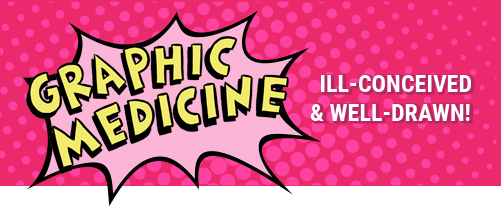About the Module
Author
Michael Green is a physician, bioethicist, and one of the founders of the Graphic Medicine field. He has pioneered the teaching of Graphic Medicine for medical students, and has been using comics in medical education for many years. At Penn State College of Medicine, he teaches a course where fourth-year medical students read and discuss medically-relevant graphic narratives (or comics), and then create their own comic, based on a formative experience in medical school. The course has been popular and rewarding for both Dr. Green and students. The disarming medium of comics provides an accessible way to enter conversation about difficult topics, and students enjoy learning in this unconventional way. Moreover, the comics course offers students an opportunity for creative reflection and self-expression. When given the chance to tell their own stories using the comics medium, students reveal much about themselves and the culture of medicine that impacts the formation of professional identity. Using comics as a vehicle for reflection and creativity has been of great value to students at the Penn State College of Medicine. This module, Comics for Health and Medicine, is an instructional template with suggested class resources that others can adapt for use in their own setting.
Dr. Green is a member of the editorial collective for the Penn State University Press Graphic Medicine book series, and is co-author of Graphic Medicine Manifesto (Penn State Press, 2015). He also is a guest editor of the Graphic Medicine section of Annals of Internal Medicine, where he has published two of his own comics stories.
Dr. Green wishes to acknowledge the valuable input of several other teachers of Graphic Medicine who generously shared their syllabi for this project: Amerisa Waters, Jerome Crowder, MK Czerwiec, Matthew Noe, Ann Fox, Jared Garder, Katherine Houpt, Sarah Leavitt, and Susan Squier.
Suggested Use
Comics for Health and Medicine introduces students to the use of graphic narratives (or comics) as a medium for communicating stories about health, illness, loss, suffering, and hope. This module is adapted from a course for fourth-year medical students at Penn State College of Medicine, but is suitable for anyone interested in the intersection of medicine (broadly construed) and comics. It is designed to inform and challenge students to better understand the varied experiences of people who interact with the health care system, and is particularly suited for those who are training to be health care professionals.
The Comics for Health and Medicine module does not require students to have any background in art or literature. A variety of creative in-class activities help students better appreciate the comics medium, and provide an opportunity for them to reflect on their own experiences about becoming a health care professional.
Each class is planned for 60–90 minutes, and includes two main activities: 1) reading and discussing comics and other assigned texts; and 2) engaging in a writing or drawing exercise to promote creative reflection. For instructors who have the time and interest, Class 7 outlines an optional comics-making project for students to create a short comic about their own experience with health, illness, and the health care system.
Below is a list of suggested supplies and materials for in-class activities and homework:
- Sketch book (8 x 10”)
- A composition notebook (9 ¾” x 7 ½”) for daily diary
- Several soft pencils (#2 or HD)
- Fine point permanent ink markers
- Packet of 4 x 6” white, non-ruled index cards
In addition to the supplies listed above, below are some resources that may be helpful to students and teachers of this module:
- McCloud, Scott. Understanding Comics: The Invisible Art. New York: William Morrow Paperbacks, reprint edition, 1994.
- Graphic Medicine [http://graphicmedicine.org/]. A website devoted to comics and medicine.
- Drawing Words and Writing Pictures [http://dw-wp.com/]. A website with activities, tutorials, and advice for people who want to learn more about making or reading comics.
- The Center for Cartoon Studies [http://www.teachingcomics.org/copy.php]. This website includes a link to “Teaching Comics,” where there are number of instructional materials contributed by those who have taught comics.
Objectives
After completing this higher education module students will be able to:
- Recommend some graphic medicine titles that illustrate the relevance of comics to medicine
- Demonstrate how comics can be used to communicate varied perspectives on health and illness
- Show how comics can help health professionals communicate effectively with one another
- Critically reflect on prior experiences and assumptions about health and illness
- Optional objective: apply the skills from this course to create a short comic about one’s experience with illness or medicine






